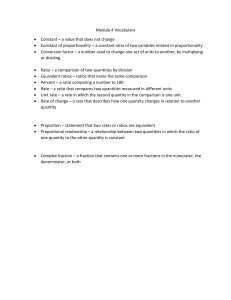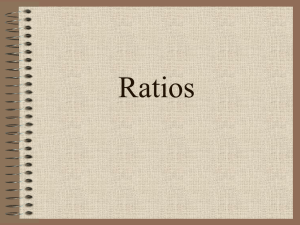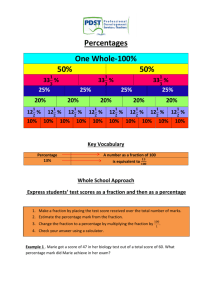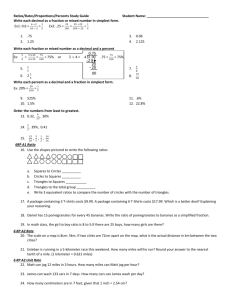Ratios and Proportions
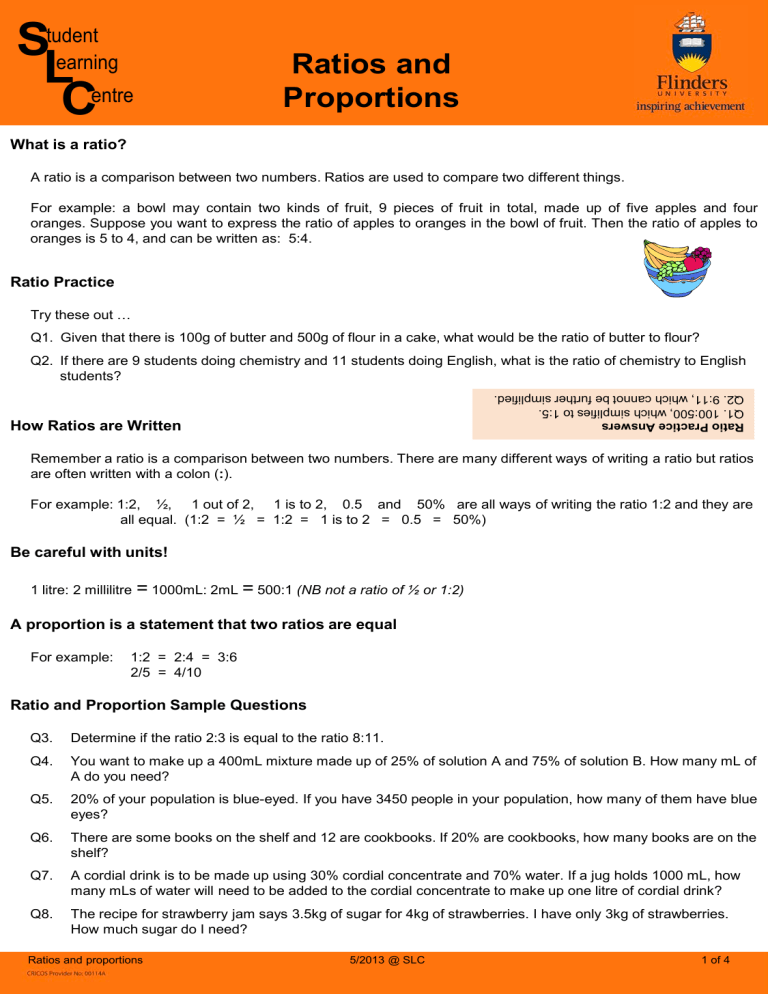
S
tudent
L
C
entre
Ratios and
Proportions
What is a ratio?
A ratio is a comparison between two numbers. Ratios are used to compare two different things.
For example: a bowl may contain two kinds of fruit, 9 pieces of fruit in total, made up of five apples and four oranges. Suppose you want to express the ratio of apples to oranges in the bowl of fruit. Then the ratio of apples to oranges is 5 to 4, and can be written as: 5:4.
Ratio Practice
Try these out …
Q1. Given that there is 100g of butter and 500g of flour in a cake, what would be the ratio of butter to flour?
Q2. If there are 9 students doing chemistry and 11 students doing English, what is the ratio of chemistry to English students? d. lifie imp s
5. o 1: urther s t ie
be f plif im h s h cannot hic hic w
500, w
9:11,
100:
Q2.
Q1.
How Ratios are Written ers nsw ice A Pract io Rat
Remember a ratio is a comparison between two numbers. There are many different ways of writing a ratio but ratios are often written with a colon ( : ).
For example: 1:2, ½, 1 out of 2, 1 is to 2, 0.5 and 50% are all ways of writing the ratio 1:2 and they are all equal. (1:2 = ½ = 1:2 = 1 is to 2 = 0.5 = 50%)
Be careful with units!
1 litre: 2 millilitre
=
1000mL: 2mL
=
500:1 (NB not a ratio of ½ or 1:2)
A proportion is a statement that two ratios are equal
For example: 1:2 = 2:4 = 3:6
2/5 = 4/10
Ratio and Proportion Sample Questions
Q3. Determine if the ratio 2:3 is equal to the ratio 8:11.
Q4. You want to make up a 400mL mixture made up of 25% of solution A and 75% of solution B. How many mL of
A do you need?
Q5. 20% of your population is blue-eyed. If you have 3450 people in your population, how many of them have blue eyes?
Q6. There are some books on the shelf and 12 are cookbooks. If 20% are cookbooks, how many books are on the shelf?
Q7. A cordial drink is to be made up using 30% cordial concentrate and 70% water. If a jug holds 1000 mL, how many mLs of water will need to be added to the cordial concentrate to make up one litre of cordial drink?
Q8. The recipe for strawberry jam says 3.5kg of sugar for 4kg of strawberries. I have only 3kg of strawberries.
How much sugar do I need?
Ratios and proportions 5/2013 @ SLC 1 of 4
Ratio and Proportion Worked Solutions to Sample Questions
Q3. Determine if the ratio 2:3 is equal to the ratio 8:11.
To work it out, firstly write the ratio as a proportion:
2
3
=
8
11
Then you can either:
(a) remember that for fractions to be equal, you must be able to multiply top and bottom numbers by the same amount, which does not work in this case:
2
×
4
=
8 2
×
4
=
8
Multiplying the first fraction by the same number on both top and bottom of the fraction, and not getting the numbers in the second fraction, tells us these two fractions are not equal.
2
3
=
8
11
3
×
4
≠
11
2
3
=
8
12
3
×
4
=
12
(b) replace one of the numbers with a ? and use cross-multiplication to work out that the ratios are not equal:
2
3
?
11
Multiply along the orange line: 2 x 11 = 22
Divide along the second orange line: 22/3 = 7.33 (approx.)
Since 7.33 is not equal to 8, you know the ratios are not equal.
Q4. You want to make up a 400mL mixture made up of 25% of solution A and 75% of solution B.
How many mL of A do you need?
The total mixture is 400mL and the number of mLs of A is what we don’t know and want to find.
25% of A and 75% of B means that ¼ of the mixture will be A and ¾ will be B.
Since we want to find the number of mLs of A, we use the ratio ¼.
Multiplying by the same number on both top and bottom of the fraction keeps the fraction the same.
1
×
100
=
100
1
4
=
?
400
4
×
100
=
400
The answer is that we need
100mL of solution A.
Ratios and proportions 5/2013 @ SLC 2 of 4
Q5. 20% of your population is blue-eyed. If you have 3450 people in your population, how many of them have blue eyes?
The total population is 3450 and we want to know how many of them have blue eyes. If 20% are blue-eyed, this means that
20
100
=
1
5
of the population is blue-eyed. We write our equation this way:
1
×
690
=
690
Multiplying by the same number on both top and bottom of the fraction keeps the fraction the same.
1
5
=
?
3450
5
×
690
=
3450
The answer is that 690 people are blue-eyed.
Q6. There are some books on the shelf and 12 are cookbooks. If 40% are cookbooks, how many books are on the shelf?
There are 12 cookbooks and the total number of books is what we want to know. If 40% are cookbooks, this means that
40
100
=
2
5
of the books are cookbooks. We write our equation this way:
2
×
6
=
12
Multiplying by the same number on both top and bottom of the fraction keeps the fraction the same.
2
5
=
12
5
×
6
=
30
?
The answer is that there is a total of 30 books on the shelf.
Q7. A cordial drink is to be made up using 30% cordial concentrate and 70% water. If a jug holds
700 mL, how many mLs of water will need to be added to the cordial concentrate to make up one litre of cordial drink?
The total mixture is 700mL and the number of mLs of water is what we want to find out. 30% of concentrate and
100 10
Since we want to find the number of mLs of water, we use the ratio 7/10.
100 10
7
×
70
=
490
Multiplying by the same number on both top and bottom of the fraction keeps the fraction the same.
Ratios and proportions
7
10
=
?
700
10
×
70
=
700
5/2013 @ SLC
The answer is that we need 490mL of water.
3 of 4
Q8. The recipe for strawberry jam says 3.5kg of sugar for 4kg of strawberries. I have only 3kg of strawberries. How much sugar do I need?
I need 3.5kg sugar and 4kg strawberries, which makes the ratio this as follows:
3.5 𝑥𝑥
3
4
= 2.625
3.5: 4
or the fraction
3.5
4
. But, since I only have
3kg strawberries, I want to know how much sugar will keep the proportion of sugar to jam the same. I can write
The answer is that we need
2.625kg of sugar.
Multiplying by the same number on both top and bottom of the fraction keeps the fraction the same.
3 .
5
=
4
?
3
4
×
3
4
=
3
This time, it’s trickier to see what to multiply 4 by in order to get 3. If it is too hard to see, you can always use the cross- multiply method below.
Finding Ratio Amounts – STEPS
1.
Write the ratios our vertically.
2.
Make sure there are three numbers present and one unknown letter variable.
3.
Cross multiply the items.
4.
Divide both sides by the number which is in front of the letter variable.
5.
Write the simplified answer.
Ratio Amounts – Example One Ratio Amounts – Example Two
Ratios and proportions
S TUDENT L EARNING C ENTRE
R EGISTRY BUILDING ANNEXE
T EL : 61-8-8201 2518
EMAIL : slc@flinders.edu.au
I NTERNET : http://www.flinders.edu.au/SLC
P OSTAL : PO B OX 2100, A DELAIDE , SA 5001
5/2013 @ SLC 4 of 4
